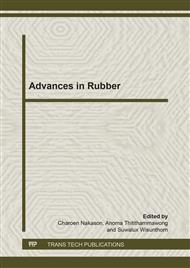p.259
p.263
p.267
p.272
p.276
p.280
p.285
p.289
p.293
Surface Modification of TiO2 Nanoparticles by Grafting with Silane Coupling Agent
Abstract:
Titanium dioxide (TiO2) possesses excellent photocatalytic activity and provides UV protection for polymeric materials. The nanosized TiO2 particles with larger surface area to volume ratio and an increased surface reactivity shall impart better photocatalysis and UV protection efficiency to the rubber compounds, compared to the use of conventional micron-sized particles. Direct incorporation of TiO2 nanoparticles (n-TiO2) into non-polar rubbers faces incompatibility problem between the two phases. One of the solutions to overcome this problem is to treat the nanoparticle surface by using silane coupling agent such as bis-(3-triethoxysilylpropyl) tetrasulfide (TESPT). This work prepared n-TiO2 from commercial micron sized-TiO2 by ultrasonication technique. Particle size of TiO2 was measured by laser light scattering particle size analyzer. The morphology of TiO2 nanoparticles was characterized by field emission scanning electron microscope (FESEM). The grafting reaction of silane on TiO2 nanoparticles surface was studied at varying reaction temperatures and times. The purified grafted materials were characterized by energy dispersive X-ray analysis (EDX), thermogravimetric analysis (TGA) and Fourier transform infrared spectroscopy (FTIR). The characterization data confirm a presence of grafted silane on the TiO2 nanoparticles surface. The result shows that ultrasonication technique can effectively decrease particle size and the grafting reaction of silane coupling agent onto TiO2 nanoparticles can be successfully carried out at 140°C for 8 h.
Info:
Periodical:
Pages:
276-279
Citation:
Online since:
November 2013
Price:
Сopyright:
© 2014 Trans Tech Publications Ltd. All Rights Reserved
Share:
Citation:


